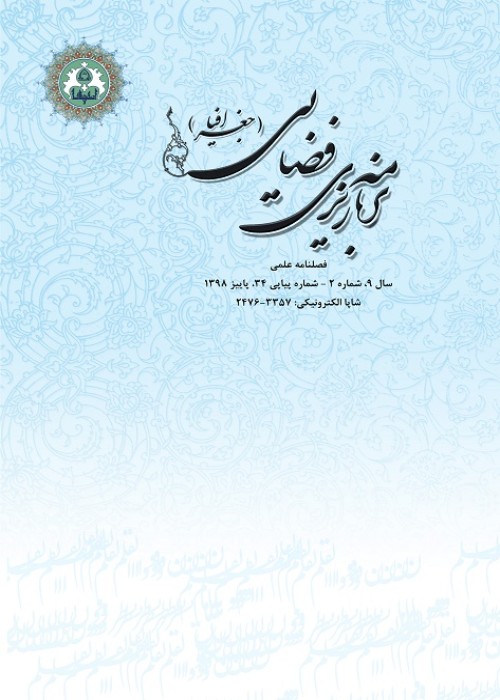Analysis of Indicators and Explanation of Strategies for Achieving Urban Intelligence: A Case Study of Isfahan
Urbanization is now happening at an unprecedented rate. Continued population growth and urbanization are projected to add 2.5 billion to the world's urban population by 2050. Along with the physical progress in the cities of the world, finding solutions to problems in urban areas is very important. In response to inefficient and unsustainable patterns of urban growth, concepts such as urban intelligence have emerged forcing many planners to seek new ways to understand and pursue regional and large-scale spatial planning (Sciara, 2020, p. 1). It aims to improve the quality of life for residents in terms of personal, social, cultural, economic, environmental, and physiological aspects. In recent years, Iran’s metropolises, including Isfahan, have faced new challenges in terms of environmental sustainability, economic growth, population, and technological progress. As a result, today’s cities need integrated policies and innovative new methods to manage and improve the complexity of urban living conditions. It should be noted that the metropolis of Isfahan is facing many changes in the economic, social, managerial, etc. areas. The realization of intelligence can be provided by presenting appropriate solutions to reduce the cost of infrastructure and urban services, excessive use of cars, air pollution, water, etc. that helped managers and city officials. Therefore, in order to improve the city and its public services, there is a need for measures and tools that increase urban efficiency and performance. Urban planners need to implement smart solutions to strengthen the city’s competitiveness, improve environmental and economic efficiency, facilitate resilience, and emphasize this approach to energy production and distribution, transportation, waste management, and pollution control.
This study aims to investigate the effective components in smartening the city of Isfahan.
This research is applied-developmental in terms of purpose, and descriptive-analytical and survey in terms of method. Data collection was done using both library and field methods and referring to documentary sources, articles, and related theories. After extracting and comparing the indicators in the approaches of scattered cities, compact cities, smart growth, electronic cities, and smart cities, important and common indicators for smartening in the form of 5 dimensions were developed including physical-spatial (8 items), environmental-ecological (5 items), economic (8 items), social (8 items), and managerial-political (8 items). Each of these dimensions has sub-criteria that form the basis of the present research. To achieve the objectives of the research (i.e. analysis of the main components of intelligence approaches and analysis of weaknesses, strengths, threats and opportunities to achieve intelligence in Isfahan), factor analysis and the SWOT model have been used. The statistical population of the study includes experts and trustees of Isfahan municipality, urban planning, intelligence, urban planning, and university professors. The sample size was selected based on the snowball sampling method of 60 people and a questionnaire was distributed among them.
Analysis of the main components of smartening approaches in IsfahanThe factor analysis method was used to identify the underlying dimensions of the research. By summarizing the variables in the form of new factors, their importance was categorized in order of importance and the main components in terms of smartening the city of Isfahan were prioritized over the research variables based on the opinions of experts and trustees. Finally, that managerial-economic, environmental-economic, physical, and social factors were recognized as the most important factors in the development of intelligence in Isfahan, and these factors explain 64% of the total variance.Analysis of strengths and weaknesses, opportunities and threats of smartening in Isfahan metropolis and ways to improve itRegarding the existing weaknesses in order to achieve intelligence in the city of Isfahan, the lack of management in waste and urban recycling with a score of 0.656, is the most important weakness in the system that needs improvement in terms of planning.Analysis of external factors affecting the realization of intelligence in IsfahanOrganizing public transportation with a score of 0.602 is an opportunity to realize the intelligence of the city of Isfahan. The unavailability of quality facilities and services with a score of 0.634, is considered the most important threat to the realization of intelligence.Urban planners emphasize that the importance of cities in the regional, national, or global economy is increasing. In this regard, with the aim of improving aspects such as quality of life and empowerment of citizens, urban intelligence is considered a conceptual scenario and urban planners are widely encouraged to implement smart solutions. The metropolis of Isfahan, the third most popular city in Iran and the fourteenth most popular city in the Middle East, needs to create perspectives to create a safe and sustainable environment for living and working in urban programs. Therefore, the present study was conducted with the aim of analyzing the main components of smartening approaches in Isfahan. The results of factor analysis based on the 37 variables show that the four factors of economic-managerial, economic-environmental, physical, and social aspects have the highest variance and are the most important components in the development of intelligence in Isfahan. Using the SWOT model, the strengths, weaknesses, opportunities, and threats of smartening in Isfahan were identified and relevant strategies were presented.Innovation: The concept of ‘Smartening cities’ is the ultimate form of approaches such as scattered cities, compact cities, smart growth, electronic cities, and smart cities which form and complement each other over time. In the present study, the common indicators of these theories were used to smarten Isfahan city.
- حق عضویت دریافتی صرف حمایت از نشریات عضو و نگهداری، تکمیل و توسعه مگیران میشود.
- پرداخت حق اشتراک و دانلود مقالات اجازه بازنشر آن در سایر رسانههای چاپی و دیجیتال را به کاربر نمیدهد.


